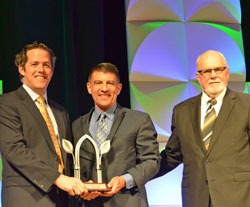 Some Minnesota 4-H students are learning more about science, thanks to biodiesel. This story from the St. Paul Pioneer Press says this knowledge could help these kids fill an expected 1,000 person gap in those able to fill the business, science engineering and agriculture jobs in this country each year.
Some Minnesota 4-H students are learning more about science, thanks to biodiesel. This story from the St. Paul Pioneer Press says this knowledge could help these kids fill an expected 1,000 person gap in those able to fill the business, science engineering and agriculture jobs in this country each year.
For junior high and high school students, “4-H involvement could lead to college, university or even trade school and an ag-related job,” said Josh Rice, who runs the science of agriculture programming at University of Minnesota Extension. “Agricultural awareness is a very important piece of this. There are ag jobs out there and it’s not just production agriculture. It can be marketing, processing, distribution and even social science.”
Minnesota is the first state to start a 4-H Science of Agriculture Challenge, which is a team competition showing science and engineering understanding. The teams have three or four members between grades six and 12 who share a common interest. A coach guides them through the scientific or engineering process. The teams also meet with a mentor from the industry, who gives guidance and an inside view of an agricultural career.
Brian and Anna Prchal of Montgomery and their cousin Tyler Fromm of New Hope teamed up to work on biodiesel.
Jodi Prchal, Brian and Anna’s mother and a fifth-grade teacher, is their coach.
Brian created biodiesel from used fryer oil at a local restaurant. He describes the process in detail on how to transform that oil into fuel.
“You can burn straight filtered vegetable oil in a diesel engine, but it gums up the engine,” Brian said…
Jodi Prchal says the critical moment came when they tried it in an engine. Brian had bought a single-cylinder, nine horsepower diesel engine and it ran smoothly on the biodiesel.
The article goes on to say that Brian learned how to make biodiesel for just 70 cents a gallon, as opposed to the $4 a gallon conventional diesel goes for. Anna and Tyler learned how much cleaner the biodiesel burned and how much better it was for engine wear.
Later this summer, they’ll present their work to a panel of judges and compete for scholarship money. Organizers would like to see this state program go nationally.
 Awards were presented at the 2015 Fuel Ethanol Workshop on Tuesday morning, honoring those who have helped the ethanol industry move forward.
Awards were presented at the 2015 Fuel Ethanol Workshop on Tuesday morning, honoring those who have helped the ethanol industry move forward. John Caupert, director of the National Corn Ethanol Research Center (NCERC) at Southern Illinois University – Edwardsville, received this year’s Award of Excellence. Caupert has more than two decades of experience in the agriculture and biofuels industries and was hired to the NCERC post in 2006.
John Caupert, director of the National Corn Ethanol Research Center (NCERC) at Southern Illinois University – Edwardsville, received this year’s Award of Excellence. Caupert has more than two decades of experience in the agriculture and biofuels industries and was hired to the NCERC post in 2006.










